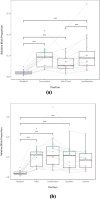The timing of spontaneous eye blinks in text reading suggests cognitive role
- PMID: 40473803
- PMCID: PMC12141466
- DOI: 10.1038/s41598-025-04839-y
The timing of spontaneous eye blinks in text reading suggests cognitive role
Abstract
A growing body of research suggests that spontaneous eye blinks have a cognitive role in addition to their biological functions. Blinking has been associated with cognitive effort and with processes related to the dynamic nature of incoming sensory information, such as the release of attention. However, there is limited evidence supporting the cognitive role of spontaneous blinks, specifically during reading. This study provides the first systematic investigation of blinking patterns in eye-tracking data of naturalistic silent text reading. We hypothesized that blinks would be more likely to occur (1) around punctuation marks signaling a breakpoint in the text and (2) following fixations on lower-frequency and less predictable words. To test these hypotheses, we utilized data from the large Ghent Eye Tracking Corpus (GECO), which contains eye movement data from 15 participants who read an entire novel in silence. The results indicate higher blinking proportions at punctuation marks compared to other positions in the text. Additionally, blink rates were modulated by word frequency and predictability, with higher word frequencies and predictabilities significantly reducing the probability of blinking. Extending previous research, our findings suggest substantial cognitive regulation of blinking during reading.
Keywords: Attention; Corpus study; Eye tracking; Reading; Spontaneous eye blinks.
© 2025. The Author(s).
Conflict of interest statement
Competing interests: The authors declare no competing interests.
Figures



Similar articles
-
Extracting blinks from continuous eye-tracking data in a mind wandering paradigm.Conscious Cogn. 2022 Apr;100:103303. doi: 10.1016/j.concog.2022.103303. Epub 2022 Feb 25. Conscious Cogn. 2022. PMID: 35228126
-
When noise becomes signal: A study of blink rate using an eye tracker.Ocul Surf. 2024 Oct;34:516-520. doi: 10.1016/j.jtos.2024.11.002. Epub 2024 Nov 2. Ocul Surf. 2024. PMID: 39491645
-
Eye movements and blinks: their relationship to higher cognitive processes.Int J Psychophysiol. 1989 Sep;8(1):35-42. doi: 10.1016/0167-8760(89)90017-2. Int J Psychophysiol. 1989. PMID: 2584081
-
[Study on human eye movements induced by blinks--report 1. Three kinds of blinking].Nippon Ganka Gakkai Zasshi. 1995 Apr;99(4):481-6. Nippon Ganka Gakkai Zasshi. 1995. PMID: 7741062 Japanese.
-
Inhibition of eye blinking reveals subjective perceptions of stimulus salience.Proc Natl Acad Sci U S A. 2011 Dec 27;108(52):21270-5. doi: 10.1073/pnas.1109304108. Epub 2011 Dec 12. Proc Natl Acad Sci U S A. 2011. PMID: 22160686 Free PMC article.
References
-
- Mahanama, B. et al. Eye movement and pupil measures: a review. Front. Comput. Sci.3, 127 (2022).
-
- Norn, M. S. Desiccation of the precorneal film. I. Corneal wetting-time. Acta Ophthalmol.47, 865–880 (1969). - PubMed
-
- VanderWerf, F. et al. Eyelid movements: behavioral studies of blinking in humans under different stimulus conditions. J. Neurophysiol.89, 2784–2796 (2003). - PubMed
-
- Doughty, M. J. & Naase, T. Further analysis of the human spontaneous eye Blink rate by a cluster analysis-based approach to categorize individuals with ‘normal’ versus ‘frequent’ eye Blink activity. Eye Contact Lens. 32, 294–299 (2006). - PubMed
-
- Lavezzo, M., Schellini, S. A., Padovani, C. R. & Hirai, F. E. Eye Blink in newborn and preschool-age children. Acta Ophthalmol.86, 275–278 (2008). - PubMed
MeSH terms
LinkOut - more resources
Full Text Sources

